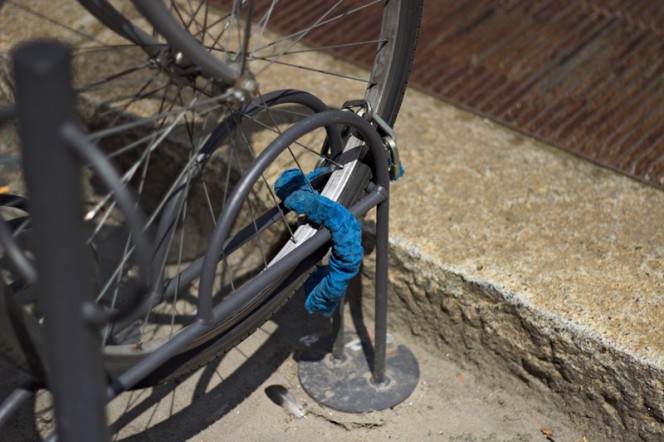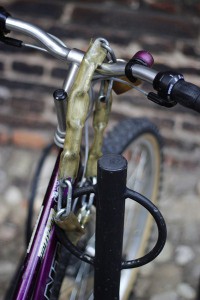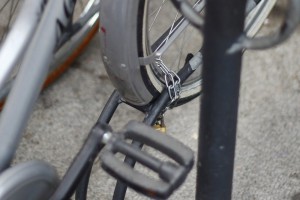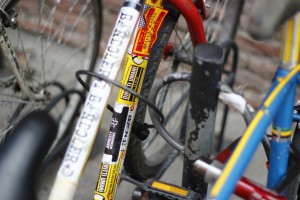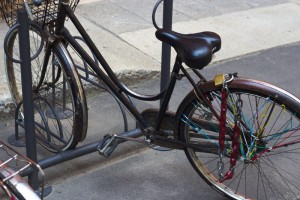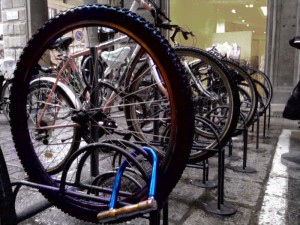Going to work by car? Using public transport? Or relying on a bicycle? The world is increasingly trying to be environmentally-sustainable and, especially in easily accessible city centres (such as Bologna), cycling is a “must”. One of the main curses for urban cyclists is that of thefts.
Stealing a bike is relatively easy because – unlike cars and motorcycles – they don’t have a number plate or a registered owner; so it is very important to protect it properly, to discourage theft as much as possible. Unfortunately, however, there are still many cyclists who lock up their bikes in such a clumsy manner that they make life particularly easy for thieves, even the less well equipped ones.
This is what we found yesterday walking around the centre of Bologna for just quarter of an hour:
1. Locking the chain so that it can be removed with just one movement
Rather than locking up the bike so that the chain can be removed with a single movement it is better not to lock it up at all: you save the effort and the result is identical.
The most common ways to lock up the chain so that it can be removed with a single movement are to wrap it around the column of the saddle (one just needs to remove it from above, or pull off the column) or even around the handlebars, like in this case:
The chain (or cable) must always pass inside a closed triangle of the frame; the one supporting the rear wheel or the central one.
2. Using a chain or a cable that can be cut with “nail clippers”
Second place in the “hit parade” is the use of steel chains or cables with such a small cross section that they can be easily cut in just a few seconds using a pocket-cutter, which can be used whilst keeping it hidden in one’s hand, so as to be almost unseen to the distracted eyes of passers-by:
The steel cables must have a cross section of at least 8 mm and the chains must not be less than 5 mm (it also depends on the materials used and, in the case of chains, the shape of the link cross section) so that they can only be cut with medium/large cutters which are difficult to carry around and use without arousing suspicion.
3. Not anchoring the bike to a fixed point
If you are using a good quality chain, but the bike is not locked to any fixed point, as in this case:
The only thing a thief needs is a bit of cheek to take the bike and carry it away by hand, as if it were his and he had just forgotten the keys at home… This is why the bike must be secured to a fixed point whenever possible.
4. Locking to a fixed point not the bike but only a wheel, possibly even just the front one
Here the bike is anchored to a fixed point and it cannot be stolen without a minimum of work:
But, unfortunately, very little is needed: it is only necessary to unscrew the 2 nuts which fix the wheel or, even easier, unlock the quick release (if fitted) to take away the bike leaving the wheel where it is, as in this case:
Yes, the thief will find himself with a bike without a wheel, but he can always obtain one easily from a bike locked up with the following error.
5. Not locking up the wheels
Not just entire bikes are stolen, but also individual pieces. If one only locks the frame to a fixed point, such as in this case:
stealing the frame is difficult, but stealing the wheels, especially the front one, is very easy and the thief then has a nice wheel to fit on the bike stolen previously. For this reason, one should try to lock up as many components as possible, starting from wheels. It is easy to tie together the wheel and frame to a fixed point with a single chain. With a second chain one can lock up the other wheel, drastically increasing the protection of the bike:
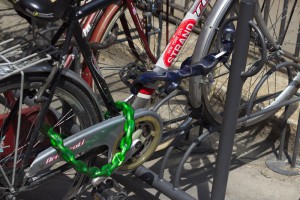
An example of how to lock up a bike well: a chain locks the front wheel and the frame to a fixed point, whilst a second chain locks the rear wheel to the frame.
6. Letting the chains, padlocks or cables touch the ground
Anything which can be cut with a cutter, such as chains, cables and padlocks, must never touch the ground.
A chain or a padlock which touches the ground can be cut more easily.
In this case, in fact, it becomes much easier to cut it with a cutter by resting one arm on the ground and loading all one’s weight on the other arm. If, on the other hand, the item is raised, it is necessary to squeeze the cutter with both hands, and, without the lever effect on the ground, the force that it is then possible to exert is much lower.
Good examples
To finish, let’s look at some examples of bikes which have been locked up in an excellent way. No anti-theft device is 100% safe, but we can be certain that between a bike locked up properly and one locked up badly a thief will always chooses the latter.

A chain with a padlock locks together the front wheel and the frame to a fixed point and a large steel cable locks the rear wheel.
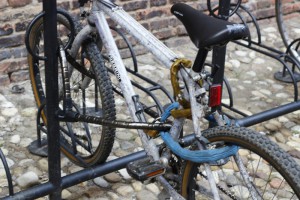
In this case, the wheel and the frame are locked to a fixed point with an armoured cable. A chain then secures the rear wheel.

The frame is anchored to a fixed point with a U-lock, which also secures the 2 wheels using a large cable.
This is a very simple but effective way to lock up the bike: a chain with a good quality padlock locks the frame and front wheel (the easier one to steal) to a fixed point.
Locking up a bike in this manner does not require any more time than locking it up badly, but is much more secure!
>> Find out the Top 3 for Bikes!
>> Look at the Viro Morso with chain technical sheet!
